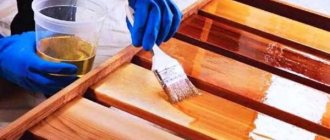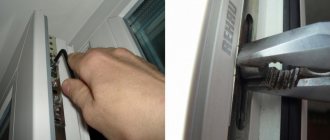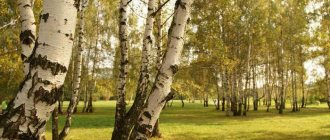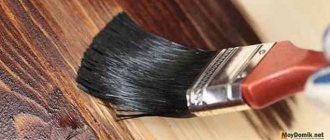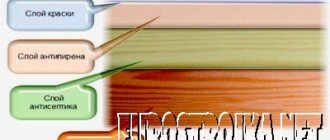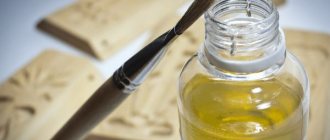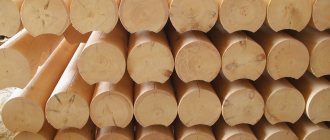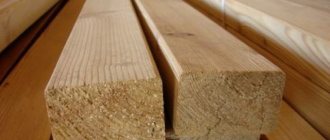Wood is an extremely common material: it is used in the construction of buildings, in the production of various furniture products, for finishing premises - the list can be continued for a long time. Its popularity is due to its environmental level, which hardly needs confirmation. However, no material can be without disadvantages. This is the case with wood, whose “Achilles heel” is susceptibility to rot and rather low resistance to high humidity conditions. That is why the question very often arises regarding how to remove mold from wood . A humid and warm environment causes the formation and rapid proliferation of harmful microorganisms that can subsequently destroy a building (or product), and also negatively affect people’s health.
Why does mold appear?
Naturally, wood, being a “natural” material, invariably contains various nutrients. Like the vast majority of natural materials, it is able to absorb liquid and “breathe”. Even a board dried in a special way can contain up to twenty percent moisture. It is not surprising that mold is often “interested” in wood. Let us highlight the main reasons causing the appearance of fungus on a wooden surface in the form of a list:
- Improper food storage conditions.
- Lack of proper level of treatment (there are a huge number of different means that protect wood from mold and rot ; however, they are rarely used).
- Illiterate installation of wooden structures (if they are in direct contact with the ground, sooner or later you will have to face the problem of mold).
- Using the material in rooms with high humidity in the absence of a high-quality ventilation system (for example, rarely does anyone care about creating ventilation in a summer country house).
- Lack of good internal and warm waterproofing.
- Lack of special insulation (if we remember the realities of harsh Russian winters, it is hardly surprising that wooden structures can seriously freeze).
Ways to fight
To understand that there are problems, it is enough:
- Inspect the surface - black, white, green inclusions indicate the initial stage of fungal development.
- Smell - the smell of rot and dampness, if it has not led to the formation of a harmful coating, will soon do so.
- Consider the wettest places - the wood becomes loose, and liquid releases when pressed. The risk of chipping due to mechanical damage increases.
If the fungus has already been detected, it is important to start fighting as soon as possible. The more time a problem is ignored, the more difficult it is to suppress it completely.
Chlorine bleach
Dilute in cold water in a concentration of 1:10. Apply to the surface using a sponge or spray bottle well soaked in the solution.
After applying the product, let it sit for 5-7 minutes until absorbed. Then use a stiff brush to remove the dirt. Wipe the cleaned surface dry with a towel and allow to dry. Next, treatment is applied with primer mixtures and paint coatings, which protect the wood and prevent the development of fungus.
Chlorine does not destroy the surface of varnished coatings, so it can also be used for garden furniture. The unpleasant smell in the open air disappears after 2-3 hours.
Advantages:
- Cheap remedy.
- Easy to use.
- Absorbs well and penetrates into deeper layers.
- Can be used on any wooden surfaces.
- Well protects the facades of residential buildings at high humidity.
Flaws:
- Unpleasant pungent odor.
When spraying chlorine-containing liquid, it is important to use a respirator and also protect the mucous membranes of the eyes from exposure to aggressive chemicals. After work, wash your hands and face with soap.
Ammonia
Suitable for wood processing outdoors only. In the place where the fungus accumulates, you must first clean the surface by brushing it with a stiff brush.
Pour the ammonia into a wide container, wet the brush and quickly apply the solution to the prepared area. Repeat the procedure 3-4 times, performing all movements quickly.
Ammonia does not cause additional swelling of the wood, so after treatment you can apply varnishes and paints within 2-3 hours.
Advantages:
- Ease of use.
- Quickly absorbed.
- Lightens the surface of wood.
- Destroys a large number of types of mold.
- It's cheap.
Flaws:
- Need to work outdoors.
Expert opinion
Levin Dmitry Konstantinovich
Ammonia has a pungent odor, so be sure to use a respirator when working. Avoid contact of the substance with skin and mucous membranes. An excess of ammonia in the respiratory tract leads to intoxication.
Boric acid
Add 1 bottle of boric acid in liquid form to a glass of warm water. Stir well and use a spray bottle to irrigate the damaged surface of the tree. Allow to dry and repeat the procedure for 3-4 days.
It is not recommended to apply boric acid in its pure form. This can lead to the destruction of wood fibers, which will subsequently negatively affect the condition of the structure and significantly reduce its service life.
Advantages:
- Cheap and easy to use.
- Does not have a pungent odor.
- Penetrates into deep layers of wood.
- Does not destroy the protective layer.
Flaws:
- There is a need for multiple applications to completely kill mold.
Boron is less toxic than chlorine and ammonia, but its concentration in the working solution should not be exceeded. When using a spray bottle, you should always wear a respirator, safety glasses, and gloves.
Special antibacterial agents
The market for building materials and special products offers a wide selection of antiseptics that help get rid of existing mold and prevent the emergence of new areas of wood damage. The best of them are the following options.
Belinka
The product is poured into a spray bottle or applied with a wide brush (sponge), and then allowed to dry.
Advantages:
- natural water base;
- has no unpleasant odor;
- The product is completely ready for use (does not require dilution in water).
Flaws:
- high consumption of product (1 liter per 5 m2).
Senezh BIO
The surface is cleaned of fungal infections, the solution is applied with a sponge, allowed to absorb, then washed off with water and dried.
Advantages:
- destroys all types of fungus;
- suitable for any wooden surfaces;
- low consumption;
- quickly absorbs into deep layers.
Flaws:
- high consumption of product (1 liter per 5 m2).
Neomid 430
The solution is applied to the surface using a sponge and allowed to dry.
Advantages:
- absorbs well;
- the composition is non-toxic;
- does not require rinsing with water;
- does not wash out in the presence of precipitation.
Flaws:
- not found.
Homeenpoisto Tikkurila
Diluted with water 1:3, sprayed onto the prepared surface, left until completely dry.
Advantages:
- quickly absorbed by wood pores;
- non-toxic;
- Suitable as a base for varnish coating.
Flaws:
- not found.
Experts recommend carefully reading the instructions on the packaging, as well as following the manufacturers' advice. It is important to take precautions and not experiment with dosages.
Main subtypes of mold
Naturally, there are a huge number of types of mold. It is not possible to analyze each of them in detail: this would require writing not just an article, but an entire book. However, it is quite possible to identify the most common subspecies using “general” classifications. Wood processing specialists distinguish the following subtypes of mold (differentiation is based on color):
- black;
- red;
- white;
- gray;
- yellow;
- blue;
- green;
- brown.
Experience suggests that red rot most often affects coniferous trees, and owners of oak or birch structures have to deal with white rot (a similar situation with yellow rot). Green rot “specializes” in oak structures, and also “loves” to cover the ceilings and beams of basements and cellars. The most common type of mold is black: it can appear on almost all wooden surfaces.
Honey mushrooms
Rarely on buildings, but more often around them, an amazing type of coal-black mycelium is found that lives on inanimate trees. We are talking about autumn honey mushrooms (Armillaria), which are the most important causative agents of root rot. Growing on fallen trunks, rotten stumps and other woody debris, the mycelium of this fungus grows through the ground and forms white rot.
Thanks to its anomalous mycelium, the honey fungus is probably the largest and oldest living creature on the planet.
Destruction of mold on wood: why it is important
Now we will explain why the question of how to get rid of mold on wood arises at all. In the analysis, we will focus primarily on black mold, since this type is the most common and is extremely dangerous to the health of any person. Black rot is capable of penetrating into wood “fabric” to a very great depth, which is why it can quickly destroy almost any building. It also affects the human body; Let's clarify:
- The developing stroke invariably releases spores into the air, which are the strongest allergens. When they enter the human respiratory system, they cause many diseases: rhinitis, pharyngitis, pneumonia, bronchitis, asthma attacks - and this is not a complete list.
- Mold negatively affects human immunity. Even not too frequent contact with the fungus can affect the condition. In this case, children and pensioners are identified as a special risk group: their body is particularly “sensitive” to such influences.
- Mold causes various skin diseases, which manifest themselves in the form of dermatitis and other inflammatory processes. It is for this reason that all our employees invariably work in special gloves that prevent contact of harmful substances with the skin.
- In some cases, mold can cause poisoning, since the product of its metabolism is a strong poison. Possible damage to the cardiovascular and nervous systems; the fungus also negatively affects the gastrointestinal tract.
- Mold penetrating into the body causes toxic tissue neuroses. The strict medical name is aspergillosis.
Pig
The piglet (Paxillus panuoides) has every right to be called the queen of the pits.
Today, in building structures, as a consequence of improper thermal insulation (ruptures in the vapor-permeable film or its complete absence), a climate that is similar to that which develops in mines.
Therefore, few people are surprised by the thickets of pigs when dismantling the roof. Little pigs live only on wood.
If you meet it on plaster, then it is most likely a representative of the oyster mushroom genus.
How to destroy mold on wood: Microwave drying
Now we will talk about how to remove mold from wood . The most modern and effective way to combat mold involves the use of special ultra-high-frequency microwave equipment, which makes it possible to destroy the fungus in the shortest possible time. This technique is significantly different from the usual ones and is just beginning to gain popularity. Therefore, we will highlight its main advantages in the form of a list:
- No chemicals. The disadvantage of the vast majority of professional mold control methods is that they involve the use of certain chemicals. The latter, in turn, can be dangerous not only for mold, but also for those people who will subsequently live (or simply visit) the premises. The microwave method does not have this drawback, since it ensures the destruction of mold solely due to temperature effects. The surface is heated to a temperature of approximately seventy degrees to a depth of thirty centimeters, causing the mold to die.
- Speed. A competent specialist who is fluent in using professional microwave equipment is able to remove mold quickly enough: the treatment is carried out in a minimal amount of time. This allows you to save significant time.
- Versatility. Another advantage of the microwave method is its absolute versatility. Absolutely any type of wood can be processed without the slightest harm to the material itself.
- Depth. The depth of radiation penetration ensures guaranteed destruction of mold: you can be sure that you will not have to deal with “relapses” later. Moreover, it is possible to process even those places that would be simply impossible to reach with other processing methods. Therefore, such treatment of wood against mold ensures guaranteed destruction of the fungus.
- Adequate cost. Despite its high efficiency, microwave processing is relatively inexpensive: you don’t have to spend enormous sums.
Fungi pests. Who are they?
If we consider wood pests in the form of a pyramid, then wood-destroying fungi and wood pests will be at the very top, occupying a dominant position. Fungi can be found in almost any wooden structure, since, as a rule, there are basements everywhere - the favorite habitats of these fungal pests, especially the house fungus. They also love to form myceliums under stairs, under floors and wherever the conditions are suitable - high humidity, warmth and access to fresh air. It is a mistakenly common belief that pests – fungi – live in enclosed spaces. Yes, more often fungi live in damp rooms - basements of wooden houses made of timber and logs. Unventilated nooks with musty air are attractive to these fungal pests. But a harmful fungus can live comfortably in the log and beam walls of a wooden house, and there are cases where harmful fungi are detected in the rafter system - log houses of wooden houses and baths.
Photo: Fungal spores are most often introduced into the internal structure of wood with the participation of bark beetles.
Photo: this is what a tree becomes if antiseptic and treatment measures are not taken in a timely manner.
Removing mold from wood: why we
Avoiding excessive modesty, we will illustrate the main advantages of our company in the form of a list:
- Price policy. The prices will be a pleasant surprise for you: we focus on a wide audience.
- Competence. All employees undergo serious selection: the company employs only those people who are familiar first-hand with the theoretical and practical intricacies of mold destruction using microwave treatment. They know how to get rid of mold on wood for sure.
- Range. Our specialists do not retreat from difficulties and do not limit the scope of their work to a narrow spectrum. Although most often we have to deal with black and white mold, we are ready to take on the destruction of fungus, regardless of its type and the degree of contamination of the room.
- Efficiency. We value our own and client's time: lateness and delays are excluded.
| Room area | Impregnation | Mechanical stripping | Disinfection from spores | Microwave drying of walls | Complex (3 year warranty) |
| 1-2 sq.m. | from 1000 rub. | from 1000 rub. | from 500 rub. | from 2000 rub. | from 3500 rub. |
| 3-5 sq.m. | from 800 rub. | from 850 rub. | from 350 rub. | from 2000 rub. | from 3000 rub. |
| 5-10 sq.m. | from 650 rub. | from 700 rub. | from 200 rub. | from 1800 rub. | from 2800 rub. |
| 10-20 sq.m. | from 500 rub. | from 600 rub. | from 100 rub. | from 1500 rub. | from 2500 rub. |
| 20-50 sq.m. | from 400 rub. | from 500 rub. | For a present* | from 1500 rub. | from 2500 rub. |
| 50-100 sq.m. | from 300 rub. | from 500 rub. | For a present | from 1500 rub. | from 2000 rub. |
| More than 100 sq.m. | negotiable | ||||
| LINEAR METER (along the baseboard, along the seams, along the joints of the walls) | 1000 rub. |
What you need to pay attention to when building a frame house
When arriving at a construction site, pay attention to how the timber is stored. It must be either in a special room or stored outside, in compliance with all requirements:
- stored on pallets so that the material does not touch the ground;
- there should be a gap of several millimeters between the boards;
- the timber must be covered with a protective film.
By following these simple rules, you can get rid of a large number of problems in the future. Our lumber is additionally treated with antiseptics during production, which allows you to avoid problems in the subsequent operation of your home.
How to fight and what to treat?
Young seedlings are easier to rehabilitate, but a certain type of fungus needs its own treatment regimen. According to reviews from gardeners, you can fight not only with Bordeaux mixture. Among the chemical preparations, the leaders are Skor, Topaz, and HOM.
Old plantings will better tolerate treatment with a solution of baking soda in a proportion of 150 g per 10 liters of water. After treatment, the tree may drop fruits, as it needs to accumulate strength before wintering. The final stage will be autumn pruning of the crown and whitewashing of the trunks.
Sooty fungus on wood deserves special attention, since once it appears, it is pointless to take action. The only way out is to trim the affected branches, strip the trunk, and then apply copper sulfate 5%.
Attention! The best protection against fungus is autumn pruning, removing old and rotten branches and then burning them.
